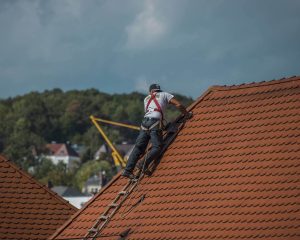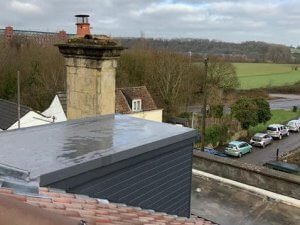With so many roofing options to choose from, deciding which type of roof is best for your property can be a difficult task. Nevertheless, whether your project is a new build, a repair or renovation, identifying the right type of roof is vital for future-proofing your property.
Not only can an appropriate roof make a huge difference to how well your home is protected and how it looks, it can also save you money in the long run, especially in terms of energy efficiency.
In this blog, we’ll be discussing the different roof types and the pros and cons of each style so you can make your decision with all the right information to hand. There are dozens of different roof styles we could talk about, so we’ve covered the most common roof types used in the UK to help narrow down your search.
 Gable Roofs
Gable Roofs
When you picture the roof of a house, it’s likely that the first shape that comes to mind is a triangle, right? The standard triangle shape is what makes the gable roof so recognisable.
The traditional gable roof is formed of two sides that meet in the middle; it is also known as an open gable roof. There are a few other variants of gable roofs that we will explore later in this blog that you may also be familiar with.
Pros: The gable roof is popular for a reason. Its simplistic design appeals to many homeowners and is one of the easiest roofs to construct. The prominent middle pitch allows for good water-drainage and a wide range of materials can be used. The shape also allows for interior loft space.
Cons: Gable roofs can struggle in extreme weather due to a lack of reinforcement. In particularly strong winds or hurricanes (rare for the UK but worth noting) they are prone to collapsing. Weather can affect roofs in many different ways so it’s an important factor to consider.
Box Gable
A box gable is a style of gable roof that doesn’t differ too significantly from the original. The key difference is that a box gable has the additional feature of two triangular extensions that are boxed in. There are no real pros or cons to choosing a box gable over the standard gable as it comes down to a preference in style.
Cross Gable Roofs
Another variation of the gable roof is the cross gable roof. Typically found on Tudor-style properties, this roof looks just as it sounds. It is essentially two gable roofs intersecting at a right angle to create a cross-like shape, most commonly an X, T or L shape.
Pros: This style is great for properties with complex layouts. It can also look fantastic if your goal is to highlight an entrance or porch. The pitches can be the same height or varying depending on preference.
Cons: Cross gable roofs are more expensive than the standard due to the complexity.
Dutch Gable Roofs
The last gable roof we’ll be discussing is the Dutch gable. This is the combination of a gable roof with a hip roof. In its most simple form, it is a gable roof on top of a hip roof.
Pros: The gable allows for the creation of extra interior loft space but is mainly chosen for aesthetic purposes.
Cons: When it comes to Dutch gable roofs, there are no real additional cons other than cost.
 Simple Hip Roof
Simple Hip Roof
The simple hip roof is the second most common roof after the gable. It has a shallower pitch compared to the gable but has a similar shape.
Pros: Simple hip roofs are more stable than gable roofs and they’re well suited to withstand harsh weather conditions.
Cons: Hip roofs are more expensive than others. The installer will have to take care when constructing due to the substantial number of seams that can lead to leaks if not maintained correctly. It is also a much more complex build so has a higher risk of design issues.
 Dormer
Dormer
A Dormer roof is a similar shape to the standard gable with the exception of an additional structure (or more than one structure) projecting vertically from one side. This is usually a window feature and tends to be the go-to style for loft-conversions.
Pros: Dormer roofs create more interior space. If a window feature is added it can also provide some much-needed natural light to a dark room or loft.
Cons: They’re usually associated with loft-conversions so may only be suitable for property owners looking to cover that cost too.
Saltbox Roof
This style of roof is known for being asymmetric. One side is a longer slope than the other, creating a shape similar to a lean-to. This type of roof is more commonly seen on older houses or industrial buildings and out-houses.
Pros: As you can see by the slope, this is a good style for those looking for excellent drainage. Saltbox roofs can be made from most materials.
Cons: They are sometimes seen as quite old-fashioned in style. Saltbox roofs lead to slanted ceilings and a loss of space and can be a difficult build to get right.
 Flat Roofs
Flat Roofs
A Flat Roof is most commonly used for commercial and industrial buildings. It is mostly flat, but has a small pitch to prevent water gathering on top and allow it to drain.
Pros: This style is suited to certain property types. The space on top can be a huge advantage to those looking to create a rooftop garden or keep solar energy panels hidden from view. Flat roofing is easy to construct and can be very budget-friendly.
Cons: Compared to the other roof styles available this is one of the most conservative options. So if you’re looking to impress, other styles may appeal to you more. A flat roof can also give an unwanted industrial look to residential properties.
Combination
Finally, the Combination Roof is known for its variety. As the name suggests, this is a style of roof that allows for a mixture of other styles to come together. It often incorporates two or more features of the other common roofs, whether it’s for practical reasons or personal taste.
Pros: Combination roofs are great for finding your own unique style and getting the features you value the most.
Cons: Due to the nature of combining designs and creating a very complex roof, this is one of the most expensive options. It can also be at risk to future issues such as leaks because of the increased need for seams and ridges to connect the features.
If you’re looking to replace an existing roof, consider why the current roof needs to be replaced and what factors have led to its deterioration. Whether it’s just wear and tear over time or the weather has affected it, these are all important things to consider when choosing your new roof to ensure the new style will stay in good condition for as long as possible.
At S&J we carry out all kinds of domestic and commercial works from restoration to complete new re-roofs down to small repairs.
If you’re looking for a reliable, trustworthy and efficient Roofing Contractor in Bath to tackle your projects, then you’ve come to the right place.
S&J Roofing is an approved member of the FMB and the Government endorsed Trust-Mark scheme which helps potential customers find reputable companies.
Our team prides itself on being able to deliver the best results for our customers at the best prices. Take a look at our diverse portfolio of contracting work and get in touch with us today on 01225 951 223 to discuss your project.









